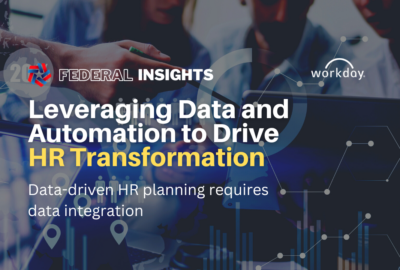Sponsored by Workday
At Interior, human capital data drives people and mission
The Interior Department's focus on human capital data analysis is born out of an effort to strategically align and support priorities of the department. Interior's...
With a workforce that spans over 11 bureaus including the Bureau of Land Management, Bureau of Indian Affairs, wildlife conservation and all 350 positions that exist in the federal workforce, the Interior Department is increasingly reliant on the data that it collects about its employees.
“About a year ago, all the human capital leaders across the bureaus came together and decided that one of our common priorities was going to be human capital data analytics,” Robyn Rees, division director for the Strategic Human Capital Initiatives in the Interior Department Office of the Secretary, said.
According to Rees, the focus on human capital data analysis is born out of an effort to strategically align and support priorities of the department. Interior’s diverse mission to protect and manage federal lands and natural resources doesn’t get done without its people. And now, the President’s Management Agenda calls for agencies to track their data to more quickly access and act on workforce needs.
“I think I would say broadly, human capital data is really central to making much of our decisions because we have 70,000 employees across 2400 operating locations. And understanding that workforce composition, the types of jobs they do, where they’re located geographically; what we’re seeing in terms of bringing people in, keeping them, keeping them happy, watching people leave. I mean, it informs so much of what we do in order to meet the mission of the public.” Rees said on Federal Monthly Insights – Leveraging data and automation to drive HR transformation. “We really have been working aggressively to get access to the data we have. Whatever quality it is, show it, let’s make it better, right? And then provide whatever sets of analyses and visualizations that could be one of a number of things.”
DoI’s goal is to use the available data for three main touchpoints. The first is reducing the burden to the bureaus for manual data calls that come up through the department and other agencies. Second, to enable those bureaus to benchmark against their peers and to access best practices from one agency or department to another. And third, to position the department to more effectively be able to advance collective efforts.
“Oftentimes, we’ll see federal government benchmarking small agencies versus small agencies, large agencies versus large agencies within the department,” Rees said.
One challenge faced by Interior is unlocking the human capital data, and the fact that there is no one system for the data that is being collected. Rees, who comes from an IT background, said that while the agency wants its customers to be able to interact with one system, that ability is born out of interactions between multiple systems.
“Part of unlocking human capital data is understanding that the data is in various systems, and being able to access it and bring light to that data is one part of it,” Rees said. “So where in the absence of an integration of a system, for example, there are other technical ways we can join that data and do something with it.”
The Office of Human Capital has already established itself as an organization that can develop enterprisewide visualization.
“We can crowdsource the feedback for those visualizations . . . through subject matter experts in the same virtual space with the data folks building and deploying visualizations,” Rees said.
Those visualizations are already assisting the department with new hires, retention, separations, exit data and capabilities around the Federal Employee Viewpoint survey. The next steps are workforce planning, succession planning, career pathways and career ladders. The information collected can help them see how an employee moves between jobs and departments at the enterprise level, and how certain skillsets can uncover newly realized career opportunities.
“You must have the language and the ability to interact with the subject matter experts in order to truly unlock what that means in terms of strategizing and using evidence to triangulate a decision space,” Rees told the Federal Drive with Tom Temin.
Interior makes use of many different types of employees to do the work of analyzing its data. They are calling on their data scientists, analytics people, their IT experts, and different subject matter experts for each phase of the work.
“I think our journey is to make sure that more people can access that data, that they then build a baseline understanding of the business, that they can build muscle and analytical thinking because now they’ll look and they’re asking more questions and ultimately we want to get them to a place where their decisions are based on evidence to the greatest extent possible,” Rees said. “And that’s the journey that we’re on, the journey that we’ll continue being on. I know as leaders of the department, we care a lot about evidence-based decision making, and it truly is a collective effort. It has to have IT folks, business folks, data folks, leaders at the table in order to keep that journey strong and moving forward. “
Copyright © 2025 Federal News Network. All rights reserved. This website is not intended for users located within the European Economic Area.
Michele Sandiford is a digital editor at Federal News Network.






